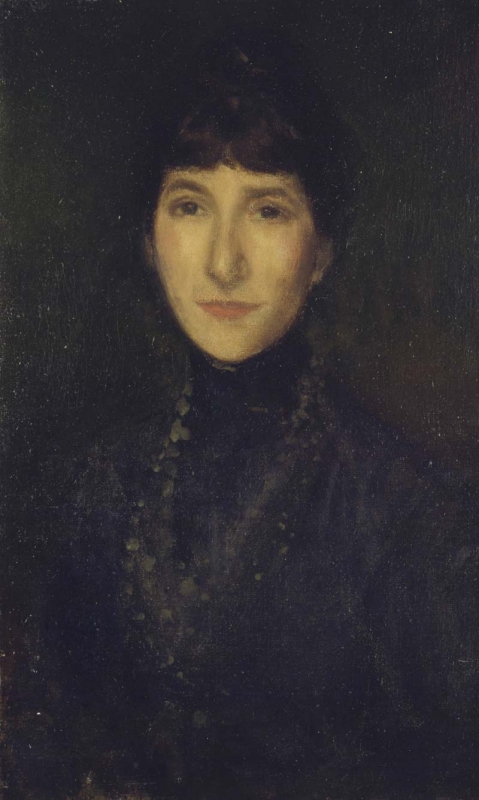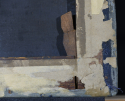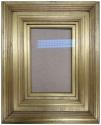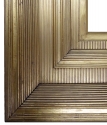Composition
In its original form, the painting was described by the Aberdeen Free Press on 16 November 1900: 'the background is green and the frame gilt ... Her white jacket is open at the neck, and there a black garment is shown.' The Pall Mall Gazette gave a slightly different account, describing it as 'a long head on a green background surmounting chalk-white dress.' 1 The title provided a puzzle for journalists, and was commented on several times. The Western Daily Press explained that the 'black heart' did not indicate wickedness, but 'only Whistler's playfulness', and the corsage was cut to create the heart-shape, while the vest was black. 2 Another newspaper asserted that 'The black V-shaped yoke of her bodice probably suggests the black heart of the title.' 3
The white was painted over so that she was shown dressed entirely in black, with a jade necklace.
Technique
It is on a plain weave unlined fabric support with 18-20 threads/cm, on its original stretcher, attached with unusual offset positioning for the tacks near the corners.
The support, unusually, is a dark navy blue fabric, with thick handspun threads, likely machine woven, dyed after it was woven rather than made from blue warp and weft threads. The one thread suitable for sampling appears to be a warp thread, a bast fibre that more resembles the cheaper ramie rather than the typical flax used to make good-quality linen canvases. The support has a dark grey commercial priming, likely based on lead white. Whistler scraped back the paint layers to reveal the top of the weave, and this priming.
Unusually for Whistler’s portraits, the reverse is thinly and fairly evenly painted in a warm dark purplish brown. This is not a conventional artist’s canvas and is possibly not a British product either.
The sitter was posed leaning slightly forward. Her small waist appears in a slightly receding plane, possibly with her right hand just in view (the surface is dark and this is difficult to distinguish). The jacket in which Miss Birnie Philip originally posed is just visible on her right shoulder. Townsend commented: 'At all stages, the shoulders were very sloping, but were made more so. The earlier jacket had a stiffened wing collar that projected out, but the "black heart" cannot be discerned, although the sitter’s right hand may just have been visible in 1900. The earlier costume was lighter but does not give an impression of whiteness. It might have been depicted as a mid-grey, only "light" in the sense that the jade necklace is lighter than the fabric depicted now.' 4
The costume is a study in nuanced shades of black (the fabric round the throat, actually made from a mixture of brown and two other pigments combined to depict a specific shade of near black) and grey (for the present bodice that overlies the black round the throat), with a greener grey for the necklace, likely including terre verte pigment. The V neck area of the costume is more thinly painted than the rest of the costume, because it was not reworked.
The infrared reflectogram suggests fairly fitted sleeves, and a fitted bodice with a rather small waist. The necklace, added by Whistler after the original painting was exhibited in 1900, is also painted very thinly.
The actual necklace survives, and is a greyish shade of jade, depicted by Whistler in the same tone. Although his brushstrokes look very impressionistic, they depict the three strands of the necklace and its graded bead size very accurately, by using one brushstroke for each bead.
The dark green background to the figure has likely been reworked over much thinner applications of paint, and now it appears untypically thick for the background of a portrait by Whistler, and very featureless.
The area around the eyes was painted extremely thinly, then severe and localised rubbing down by the artist removed some of this paint, and also paint depicting the whites of the eyes, the shadow below the nose, and the left ear.
Viewed in transmitted light from the reverse of the painting, the effect is ghostly. The eyebrows were added in thin paint after this process, but the red lips from the first painting version were retained, then the paint on the face was scraped and repainted several times to make the face longer and narrower, the lips thinner and the nose shorter. The paint for the mouth includes white, bone black, red lake, and vermilion. The flesh paint probably has some reddish earth pigment instead of the vermilion, and a lot of bone black in the early washes and in the shadows. The underlying grey priming contributes to the pearly skin tone, both because the paint on top does not fully conceal it, and because the rubbing down leaves some of it visible on the surface. The now smoothed surface of her cheeks shows traces of the thinned-down paint having been heavily worked, with the lights added last as localised brushstrokes of paler paint.
Conservation History
The painting was examined in February 2020, when a full technical examination was carried out in the School of Culture and Creative Arts Technical Art History laboratory in the Hunterian at Kelvin Hall. Professors Joyce H. Townsend and Margaret F. MacDonald examined the painting under a microscope. A high resolution camera for infra-red reflectography (IRR) was operated by Tess Visser, a PhD student supervised by Professor Christina Young, assisted by Alicia Hughes, Hunterian curatorial assistant. Images were also made of the verso, and of the recto in normal, raking, and ultraviolet light, as well as back-lit to show the very thinly painted areas, particularly around the facial features.
There are some drying cracks around the head and shoulders, and very slight paint losses and abrasions, but the painting is in a stable condition. 5 The glossy varnish of a natural resin-type was applied thinly over the earlier resin varnish, probably when it was in the frame. The green background has taken the varnish very unevenly, and shows pooling and uneven absorption of the varnish.
Frame
Grau-style frame with a fluted frieze; this is unique among Whistler's frames. It is possible that it was made in 1900 when the painting was exhibited, or after Whistler's death. 6
Jacob Simon suggested that this was similar to frames used by Mortimer Luddington Menpes (1860-1938), some of which were Japanese frames and were gilded in London by Whistler's frame-maker, Frederick Henry Grau (1859-1892). 7
Notes:
1: 'The Portrait Painters', Pall Mall Gazette, London, 17 November 1900, pp. 4-5.
2: 'London Letter', Western Daily Press, Bristol, 14 November 1900, p. 8.
3: Anon., 'Ladies' Letter', Northern Whig, Antrim, 22 November 1900, p. 2.
4: Professor Joyce H. Townsend, report, April 2017. Further technical examinations discussed here were carried out in collaboration with M. F. MacDonald, Tess Visser, a PhD student supervised by Professor Christina Young, and Alicia Hughes, Hunterian curatorial assistant, in the School of Culture and Creative Arts Technical Art History laboratory in the Hunterian at Kelvin Hall, Glasgow, February 2020.
5: Condition report by Clare Meredith, 21 May 2001, Hunterian files. Townsend, 2017, op. cit.
6: Dr S. L. Parkerson Day, Report on frames, 2017; see also Parkerson 2007 [more] .
7: Jacob Simon, National Portrait Gallery, to J. Townsend and M. F. MacDonald, 14 March 2017, citing Payne, John, 'What's in a frame: the borders of Mortimer Menpes', in Julie Robinson, The World of Mortimer Menpes: painter, etcher, raconteur, Art Gallery of South Australia, Adelaide, 2014, pp. 182-85, and table of frames, pp. 236-39; also, pp. 48, 68, 82, 88.
Last updated: 19th April 2021 by Margaret

















